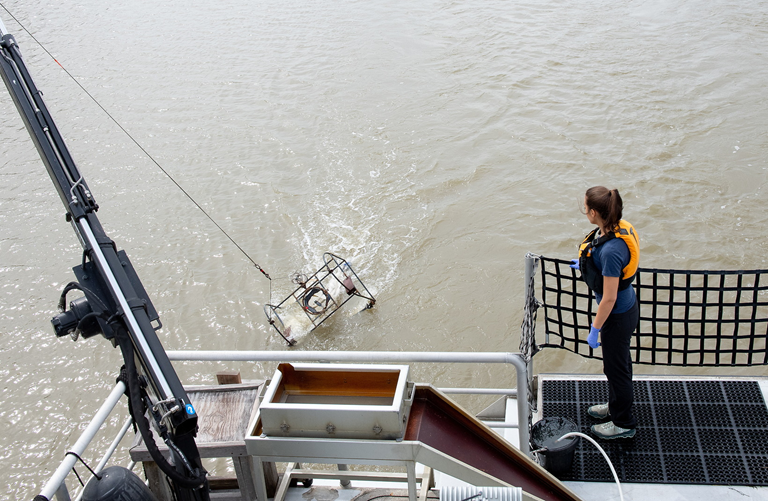DWR Research Vessel Helps Monitor Climate Change in Delta
DWR environmental scientist Morgan Martinez checks specialized netting and water collection containers while taking water samples from the Sacramento-San Joaquin Delta on DWR's research vessel the Sentinel. DWR/2020
This April marks the 50th anniversary of Earth Day, and to commemorate its theme of “climate action” the Department of Water Resources (DWR) is highlighting an important tool used for detecting the impacts of climate change in California’s Delta region; its research vessel, the Sentinel.
The flagship of DWR’s Environmental Monitoring Program (EMP), the Sentinel is used as a floating laboratory that monitors water quality and ecosystem biology in the Sacramento-San Joaquin Delta and San Francisco Estuaries.
“The data collected on the Sentinel is used by the EMP to monitor and detect long-term changes in the Delta,” said Dr. Sarah Lesmeister, DWR senior environmental scientist. “The high-quality data produced during Sentinel cruises can help reflect not only impacts of climate change, but changes that can be caused by running the State and federal water projects as well.”
The State Water Project (SWP) and federal, Central Valley Project (CVP) are water storage and delivery systems of reservoirs, aqueducts, power plants and pumping plants that move water all throughout the state. They extend more than 700 miles—and provide water to millions of Californians while also irrigating hundreds of thousands of acres of farmland. Research vessels like the Sentinel have been used to do water quality and biological monitoring of the SWP and CVP since the 1970s. The EMP and Interagency Ecological Program, a collaboration of state and federal agencies that conduct ecological investigations, use information collected from Sentinel trips to help inform decision makers about various changes in the Delta ecosystem.
“The Sentinel has been used on DWR efforts to repopulate the endangered Delta smelt fish species using cage studies, along with being used in several collaborative efforts to investigate emerging concerns like harmful algal blooms, and microplastic contamination,” Lesmeister said.
The 60-foot, 36-ton Sentinel travels up and down the 700-mile maze of sloughs and waterways that make up the Delta approximately eight days per month. Using various forms of technology like high frequency transects, it can collect data every five seconds from various water depths and conditions.
“We deploy two different kinds of nets over the side of the boat and we tow it behind us for about 10 minutes,” said Morgan Martinez, environmental scientist with DWR’s Environmental Monitoring Program. “Over the course of 10 minutes we’re able to sample the entire water column and study the health of zooplankton, phytoplankton and other nutrients in the water.”
Monitoring the health and quantity of phytoplankton (microscopic marine algae), and zooplankton (living organisms found in bodies of water) are important aspects of Delta monitoring because the health of these two organisms gives scientists an idea of the health of larger species that rely on them to survive.
“These two organisms are basically fish food,” Martinez said. “If the fish food in the Delta is abundant and healthy, the fish that eat them probably are, too.”
Along with this type of organism monitoring, the Sentinel is also capable of studying changes to water temperature, salinity, and depth.
“The Sentinel supports innovative technology to collect the highest quality of data possible that allows managers and operators to make decisions based on the best-available science,” Lesmeister said. “This makes it a vital tool in DWR’s commitment to safeguarding the State’s water resources for all its natural and human environments.”
Due to social distancing guidelines put in place from the coronavirus (COVID-19) emergency, the EMP was forced to cancel Sentinel fieldwork for the month of April. They hope to restart the program in early summer pending social distancing orders. This is the first time the EMP has had to cancel a monitoring voyage since 1975.
View our Pixel gallery for more images of the Sentinel research vessel.
